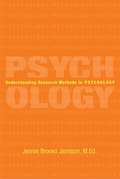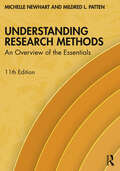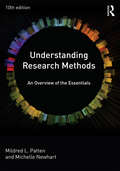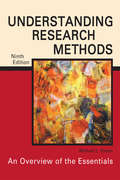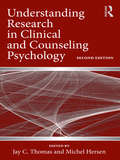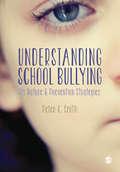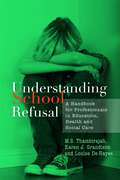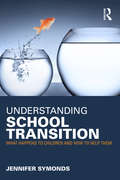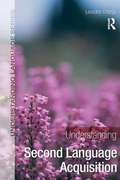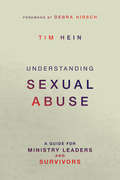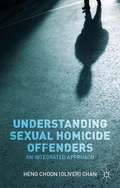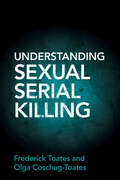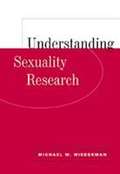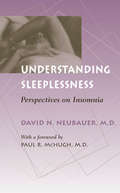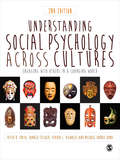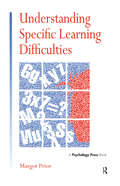- Table View
- List View
Understanding Research Methods in Psychology
by Jennie Brooks JamisonThis book has three purposes. One purpose is to help students see that there are many options available to researchers for investigating behavior and that each method has a specific goal. The second purpose is to introduce students to qualitative research methods: interviewing, observation, and case studies. International Baccalaureate (IB) students taking the Higher Level (HL) course sit for Paper 3, a section of the exam about qualitative research. I weave headings throughout the chapters on qualitative research that correspond to Paper 3 learning outcomes. These IB learning outcomes are relevant for any psychology student. The third purpose is to teach students how to design a simple experiment and analyze the data. Students taking the International Baccalaureate and/or Advanced Placement exams in psychology will find what they need in this book. Research methods are probably the most difficult part of these exams. Introductory texts do not usually provide enough depth, while the typical college-level research methods books are too complicated, sometimes even for a college student's first experience with methodology.
Understanding Research Methods: An Overview of the Essentials
by Mildred L. Patten Michelle NewhartIn the eleventh edition of Understanding Research Methods: An Overview of the Essentials, Newhart and Patten leverage the principles of learning and content design to present the fundamentals students need to get started in research. Basics of quantitative and qualitative research are covered in short, independent topics and grouped into meaningful sections. A perennial bestseller for over ten editions, Understanding Research Methods focuses concisely on key concepts, and lessons in topics that are "chunked" to suit today’s students. Each topic ends with suggestions for planning a research project by answering topic-specific prompts in a research planning journal. Topic Review exercises encourage active learning. Finally, Topics for Discussion suggest open-ended prompts that could serve as conversation starters in the classroom or online. The final Part of the book offers guidance and activities specific to writing a research report. This section can be used to support the development of project-based assignments for courses, or it can be used independently to support senior thesis projects, master’s theses, dissertations, or articles for publication. Instructors, will appreciate the organization of Understanding Research Methods because it allows a great deal of customization and choice in which topics to cover and in what order to cover them, making it suitable for methodological training in a variety of courses and fields of study. Online digital materials support course development. New to this edition: Part introductions now include a part table of contents and list of keywords Newly expanded coverage of qualitative research New coverage on designing quantitative research Expanded material on sampling More simple graphs, charts, and illustrations emphasize and visualize Topic key points
Understanding Research Methods: An Overview of the Essentials
by Mildred L. Patten Michelle NewhartA perennial bestseller since 1997, this updated tenth edition of Understanding Research Methods provides a detailed overview of all the important concepts traditionally covered in a research methods class. It covers the principles of both qualitative and quantitative research, and how to interpret statistics without computations, so is suitable for all students regardless of their math background. The book is organized so that each concept is treated independently and can be used in any order without resulting in gaps in knowledge—allowing it to be easily and precisely adapted to any course. It uses lively examples on contemporary topics to stimulate students’ interest, and engages them by showing the relevance of research methods to their everyday lives. Numerous case studies and end-of-section exercises help students master the material and encourage classroom discussion. The text is divided into short, independent topic sections, making it easy for you to adapt the material to your own teaching needs and customize assignments to the aspect of qualitative or quantitative methods under study—helping to improve students’ comprehension and retention of difficult concepts. Additional online PowerPoint slides and test bank questions make this a complete resource for introducing students to research methods. ? New to this edition: New topic section on design decisions in research Additional material on production of knowledge and research methods Significant development of material on ethical considerations in research Fresh and contemporary examples from a wide variety of real, published research Topic-specific exercises at the end of each section now include suggestions for further steps researchers can take as they build their research project.
Understanding Research Methods: An Overview of the Essentials
by Mildred L. Patten• Designed for students who are getting lost in the details of research methods and not getting the big picture, this short book provides an overview of the essential concepts traditionally covered in a research methods class. •Lively examples on contemporary topics stimulate students’ interest and show the relevance of research methods to their everyday lives. •Divided into short sections, this book makes it easy for you to give customized assignments. Assign only the sections your students need. •Shows students how to interpret statistics without computations. •Factual Questions at the end of each section allow students to check their comprehension. •Questions for Discussion stimulate classroom dialogue. • New to this edition: Five new sections on in-text citations and reference lists have been added. Numerous changes have also been made for consistency with the latest editions of the APA and ASA Style manuals, and new examples have been added.
Understanding Research in Clinical and Counseling Psychology
by Michel Hersen Jay C. ThomasUnderstanding Research in Clinical and Counseling Psychology, Second Edition, is written and designed for graduate students in the psychology and counseling fields, for whom the value of psychological research is not always readily apparent. Contributed to by experts in their respective fields, this text presents research as an indispensable tool for practice, a tool that is used every day to advance knowledge and improve assessment, treatment choice, and client outcomes. The book is divided into four logical parts: Research Foundations, Research Strategies, Research Practice, and finally, Special Problems. Included is a chapter that addresses one of the most important controversies, the distinction between realistic and "gold standard" efficacy studies. The remainder of the book addresses salient issues such as conducting research in various cultures, operating an empirically-oriented practice, and performing research with families, children, and the elderly. Students and professors will find the coverage ample and penetrating, without being too overwhelming.
Understanding Research in Counselling (Counselling and Psychotherapy Practice Series)
by Graham Bright Gill HarrisonMany counselling courses have a strong research element built into the modules and students are expected to gain a thorough understanding of research issues early on in their studies. This accessible and practical textbook will demystify research and make it relevant to counselling practice. There are sections on linking clinical practice to research, developing 'curiosity' and engaging with the data. The book uses clinical practice as a basis for understanding research, and makes connections between the activity of therapy and the research process.
Understanding Rett Syndrome: A guide to symptoms, management and treatment (Understanding Atypical Development)
by Rosa Angela Fabio Tindara Caprì Gabriella MartinoUnderstanding Rett Syndrome offers a concise, evidence-based introduction to Rett Syndrome (RTT), covering a range of topics from diagnosis and causes to treatment and family management. It focuses on improving the quality of life for those with the syndrome by suggesting practical ways of managing the condition at home and at school, offering support and guidance to all parents and caregivers learning how to help children with RTT. Over the course of six chapters, Fabio, Caprì and, Martino explore signs and symptoms of RTT, along with an overview of treatment, therapy, and interventions for those living with the condition, focusing on technological aids such as eye-tracking and ICT and new neural techniques. Illustrated with interviews with parents of children living with RTT, Understanding Rett Syndrome is essential reading for parents and caregivers, as well as practitioners in clinical and educational psychology, counseling, mental health, nursing, child welfare, public healthcare, and those in education.
Understanding Schizophrenia: A Guide to the New Research on Causes and Treatment
by Richard S. E. Keefe Philip D. HarveyA state-of-the-art title, this handbook describes the most up-to-date knowledge on cognition in schizophrenia. Cognition is perhaps the most critical aspect of the schizophrenic illness. For the first time, the authors assess the importance of cognition as an independent symptom domain, including an analysis of the costs of impairment. They focus on all the essential features of cognition in schizophrenia and discuss the clinical implications of these deficits in the everyday life of patients. New me...
Understanding School Bullying: Its Nature and Prevention Strategies
by Peter K Smith'This extraordinarily comprehensive book authored by the leading international authority in the field integrates research, theory and practice on the topic of school bullying. In an already research saturated field Peter Smith’s writing captures the humanity of why this topic strikes such a chord in the community. He reminds us in a thoughtful, practical and caring manner why we must continue to advocate on all levels for those impacted by bullying.' -Professor Phillip T. Slee, Flinders University, Australia 'Understanding School Bullying offers a refreshingly clear account of the wealth of insights gained over a quarter of a century of research. As Smith’s comprehensive review convincingly shows, much has been learned and much of this has been put to good use in improving children’s wellbeing. This is surely essential reading for any researcher concerned with bullying, childhood or life at school.' -Sonia Livingstone, London School of Economics and Political Science, UK, author of Children, Risk and Safety Online 'Peter Smith’s new book will occupy a prominent place on my bookshelf. It provides a thorough and highly readable discussion of the breadth of research on school bullying. Dr. Smith includes discussions of important challenges related to research on this topic along with an excellent review of important studies and findings. This unique volume has influenced my thinking about the direction of my own research. The book will be an invaluable resource for researchers, consumers of research, and others who seek a research-based understanding of this important topic.' -Sheri Bauman, Ph.D., Professor at University of Arizona Bullying involves the repeated abuse of power in relationships. Bullying in schools can blight the lives of victims and damage the climate of the school. Over the last 25 years a burgeoning research program on school bullying has led to new insights into effective ways of dealing with it, as well as new challenges such as the advent of cyberbullying. This new book, by a leading international expert on the topic, brings together the cumulative knowledge acquired and the latest research findings in the area, with a global perspective especially covering research in Europe, North America, Australasia, and Asia. It will appeal to those taking academic courses in psychology, social work, educational psychology, child clinical psychology and psychiatry, and teacher training, but it will also be of interest to parents and teachers.
Understanding School Bullying: Its Nature and Prevention Strategies
by Peter K Smith'This extraordinarily comprehensive book authored by the leading international authority in the field integrates research, theory and practice on the topic of school bullying. In an already research saturated field Peter Smith's writing captures the humanity of why this topic strikes such a chord in the community. He reminds us in a thoughtful, practical and caring manner why we must continue to advocate on all levels for those impacted by bullying.' -Professor Phillip T. Slee, Flinders University, Australia 'Understanding School Bullying offers a refreshingly clear account of the wealth of insights gained over a quarter of a century of research. As Smith's comprehensive review convincingly shows, much has been learned and much of this has been put to good use in improving children's wellbeing. This is surely essential reading for any researcher concerned with bullying, childhood or life at school.' -Sonia Livingstone, London School of Economics and Political Science, UK, author of Children, Risk and Safety Online 'Peter Smith's new book will occupy a prominent place on my bookshelf. It provides a thorough and highly readable discussion of the breadth of research on school bullying. Dr. Smith includes discussions of important challenges related to research on this topic along with an excellent review of important studies and findings. This unique volume has influenced my thinking about the direction of my own research. The book will be an invaluable resource for researchers, consumers of research, and others who seek a research-based understanding of this important topic.' -Sheri Bauman, Ph.D., Professor at University of Arizona Bullying involves the repeated abuse of power in relationships. Bullying in schools can blight the lives of victims and damage the climate of the school. Over the last 25 years a burgeoning research program on school bullying has led to new insights into effective ways of dealing with it, as well as new challenges such as the advent of cyberbullying. This new book, by a leading international expert on the topic, brings together the cumulative knowledge acquired and the latest research findings in the area, with a global perspective especially covering research in Europe, North America, Australasia, and Asia. It will appeal to those taking academic courses in psychology, social work, educational psychology, child clinical psychology and psychiatry, and teacher training, but it will also be of interest to parents and teachers.
Understanding School Refusal: A Handbook for Professionals in Education, Health and Social Care
by M. S. Thambirajah Karen J. Grandison Louise De-Hayes` Combining educational and clinical perspectives, and with extensive use of case studies, the authors present recent research into the mental health problems associated with school refusal, such as anxiety and panic attacks, as well as the role that parental support plays in their children's school life. They also discuss the role of home tuition services and pupil referral units in extreme cases of school refusal, and provides concrete strategies for planning and organising services to manage the problem effectively. Understanding School Refusal is a valuable guide for professionals across the disciplines of education, health and social care, and will also be useful for training courses within these fields.' Education Today School refusal is a crippling condition in which children experience extreme anxiety or panic attacks when faced with everyday school life and this handbook aims to explore and raise awareness of the problem of school refusal in children and young people, and provide plans and strategies for education, health and social care professionals for identifying and addressing this problem. Combining educational and clinical perspectives, and with extensive use of case studies, the authors present recent research into the mental health problems associated with school refusal, such as anxiety and panic attacks, as well as the role that parental support plays in their children's school life. They also discuss the role of home tuition services and pupil referral units in extreme cases of school refusal, and provides concrete strategies for planning and organising services to manage the problem effectively. Understanding School Refusal is a valuable guide for professionals across the disciplines of education, health and social care, and will also be useful for training courses within these fields.
Understanding School Transition: What happens to children and how to help them
by Jennifer SymondsSchool transition is a life changing event for children - they are rarely faced with such a powerful set of personal and social changes. These underpin the immediate and longer term wellbeing of children, peer groups, teachers and schools. Understanding School Transition provides a most comprehensive, international review of this important area, complete with practical advice on what practitioners can do to support children’s wellbeing, motivation and achievement. Offering an accessible introduction to children’s psychology at transition, Understanding School Transition explores transition as a status passage, what we really mean by wellbeing, and the ways in which children adapt to new environments. Key chapters focus on: ? Understanding stress and anxiety Children’s hopes, fears and myths at transition Parents’ and teachers’ influence and role Children’s relationships with peers as they change schools Children’s personal and collective identities Motivation, engagement and achievement Supporting the most vulnerable children ? Crucially, it advises how you can help children through implementing transition interventions and evaluating their success in your own school. Illustrated by case studies of experiences in real schools, Understanding School Transition will be essential reading for all training and practising teachers, as well as transition and subject specialists, who want to better understand and influence what happens to children at this critical stage.
Understanding Second Language Acquisition
by Lourdes OrtegaWhether we grow up with one, two, or several languages during our early years of life, many of us will learn a second, foreign, or heritage language in later years. The field of Second language acquisition (SLA, for short) investigates the human capacity to learn additional languages in late childhood, adolescence, or adulthood, after the first language --in the case of monolinguals-- or languages --in the case of bilinguals-- have already been acquired. Understanding Second Language Acquisition offers a wide-encompassing survey of this burgeoning field, its accumulated findings and proposed theories, its developed research paradigms, and its pending questions for the future. The book zooms in and out of universal, individual, and social forces, in each case evaluating the research findings that have been generated across diverse naturalistic and formal contexts for second language acquisition. It assumes no background in SLA and provides helpful chapter-by-chapter summaries and suggestions for further reading. Ideal as a textbook for students of applied linguistics, foreign language education, TESOL, and education, it is also recommended for students of linguistics, developmental psycholinguistics, psychology, and cognitive science.
Understanding Sensory Dysfunction: Learning, Development and Sensory Dysfunction in Autism Spectrum Disorders, ADHD, Learning Disabilities and Bipolar Disorder
by Liz Anderson Polly EmmonsUnderstanding Sensory Dysfunction is a clear and comprehensive resource to identifying and addressing sensory dysfunction in children, using a range of practical strategies to help them reach their full potential at home, at school and in the community. The authors explain the causes, contributing factors, symptoms and associated behaviors of sensory dysfunction, particularly when found in conditions such as autism spectrum disorders (ASDs), ADHD and bipolar disorder. Focusing on early intervention, they provide a host of tried and tested integration activities, assessment and curricular modifications, treatment options and useful equipment and resources that ultimately aim to limit or prevent the interference of sensory dysfunction with successful learning, socialization and skills development. This accessible and empowering book offers a unique approach to the condition and will help families, teachers and caregivers meet the particular needs of children with sensory dysfunction.
Understanding Sex and Relationship Education, Youth and Class: A Youth Work-Led Approach
by Sharon ElleyThis book sets out an original Youth Work-based SRE programme and explores how a range of socioeconomic, cultural and sexual norms, values and attitudes differently shape decision-making on sex, intimacy and future plans across different contexts.
Understanding Sexual Abuse: A Guide For Ministry Leaders And Survivors
by Debra Hirsch Tim Hein“It is said that the true test of a society is how it treats its most vulnerable members.” As many as one in four girls and one in six boys experience sexual abuse during childhood, and it’s estimated that as many as half of the incidents are never reported. This means that countless millions in our societies, both children and adults, carry this complex, often hidden pain. What does the path to healing look like for survivors? And how can ministry leaders, pastors, and counselors best help them as they walk this difficult road? Drawing on both his own experience and his wife's experience as survivors of childhood sexual abuse, minister and lecturer Tim Hein offers his expertise, practical guidance, and empathy—both for ministry leaders and for survivors themselves. How can we best respond when a survivor shares their secret with us? Where can survivors turn for encouragement when the road to recovery seems so long and lonely? Hein presents clinical data and resources alongside pastoral wisdom and care, addressing both psychological and spiritual aspects of sexual abuse. Both for those who have suffered sexual abuse and those in a position to help them, this book is a rich resource. Filled with both sober truths and the hope of Christ, it calls survivors to take courage and walk unafraid down the road of healing.
Understanding Sexual Homicide Offenders
by Heng Choon Oliver ChanSexual homicide generates widespread public fear and media attention, yet remains an understudied area within criminology. This book provides a thorough survey of sexual homicide offender classifications, and analyses current theoretical explanations and understandings of sexual homicide from a criminological perspective. Importantly, Oliver Chan offers a new integrated theoretical understanding of sexual homicide offenders. Understanding Sexual Homicide Offenders: An Integrated Approach isessential reading for students at all levels of study, researchers, clinicians and law enforcement practitioners seeking a comprehensive understanding of sexual murderers.
Understanding Sexual Serial Killing
by Frederick Toates Olga Coschug-ToatesWhy do some people engage in serial killing for sexual pleasure? This book considers the phenomenon of sexual serial killing from the perspective of motivation theory, as advanced in psychology and neuroscience. By examining biological, psychological and social determinants, it develops a model of sexual killing that integrates widely dispersed existing literature. The first part of the book reviews scientific data and theories, while the second part presents biographical sketches of 80 sexual killers and links their early development and later killing to current theoretical understanding. The book examines cases of serial killers from the USA, Western Europe, Iran, Australia and South Africa, and it also includes an account of killers from the USSR, made available to non-Russian speakers for the first time. Deliberately written to avoid jargon, Understanding Sexual Serial Killing is accessible to students, scholars and professionals across psychology, sociology, forensic science and law.
Understanding Sexual Violence: A Study of Convicted Rapists (Perspectives on Gender)
by Diana ScullyUnderstanding Sexual Violence examines the structural supports for rape in sexually violent cultures and dispels a number of myths about sexual violence--for example, that childhood abuse, alcohol, and drugs are direct causes of rape.
Understanding Sexuality Research
by Michael W. WiedermanWiederman (Columbia College) explains how to apply critical thinking skills to human sexuality research in order to become a more critical judge of research conducted by others. His first chapters explore the goals of the research, the participants, how questions are posed, what the results mean, and whether conclusions match the research design. Then he details ten case studies. He does not include an index. Annotation c. Book News, Inc., Portland, OR (book news. com)
Understanding Sibling Rivalry: The Brazelton Way
by T. Berry Brazelton Joshua D. SparrowThe teasing, squabbling, competition, and ferocious fights of brothers and sisters can drive any parent to frantic desperation. At the same time, Drs. Brazelton and Sparrow point out, siblings are learning from one another and deep, close relationships are forming that will last a lifetime. In this absolutely indispensable addition to the Brazelton Way series, the authors show how parents can defuse much of the bickering, while helping to strengthen warm relationships. They help parents understand the universal "Touchpoints” of sibling rivalry at each age, as well as the problems in particular family situations. From the combined delight and resentment that a sibling feels toward a new baby, to birth order, blended families, sex play, scapegoats, meltdowns, and competition in school, parents will find welcome advice in this wise, comforting book.
Understanding Sleep and Dreaming
by William H. MoorcroftAn updated edition of Moorcroft's 2003 volume, this new work reflects recent scientific advances in the area of sleep and disorders. As in the previous book, Understanding Sleep and Dreaming, this new edition serves as a compact overview for now sleep experts, covering physiological sleep mechanisms, brain function, psychological ramifications of sleep, dimensions of dreaming, and clinical disorders associated with sleep. It is accessibly written with specially boxed material that enhances the text. It also offers a good foundation for those who will continue sleep studies, while at the same time offering enough information for those who will apply this knowledge in other ways such as clinicians private practices or researchers. It is an excellent text for courses on sleep at the undergraduate and graduate levels. The section on sleep labs will show how computers have replaced former models of data collection and storage; includes the new area of the genetics of sleep; add a new box on teen sleep; insert a new box on the emerging information about how technology use affects sleep; emphasize the controversy over rampart, wide-spread sleep deprivation; and include a new box covering the connection between sleep loss and weight gain. Additional inclusions might incorporate current "hot topics," such as the effect of shift work on sleep, sleep problems in adolescents, and nightmare treatment for people suffering from PTSD.
Understanding Sleeplessness: Perspectives on Insomnia
by David N. NeubauerSeemingly the most natural and necessary of pursuits, a good night's sleep eludes a remarkable number of people—up to 50 percent of the general population, according to studies, while 10 to 15 percent suffer from severe or chronic sleep disorders. Because the causes and nature of sleeplessness are so many and varied—and often as elusive as sleep itself—the diagnosis and treatment require a flexible, multifaceted approach—and this is precisely what David N. Neubauer lays out in Understanding Sleeplessness.Building on the "four perspectives" conceptualized by McHugh and Slavney in The Perspectives of Psychiatry, Neubauer offers a much-needed explanation of the diverse ways of understanding what insomnia is and what should be done about it. He begins by surveying what is currently known about the mechanisms of "normal sleep" and, in this light, describing the problems of defining, assessing, and measuring insomnia. Drawing examples from patients studied at the Johns Hopkins Sleep Disorders Center, Neubauer then applies each of the four perspectives—diseases, dimensions, behaviors, life stories—to the varied kinds and degrees of sleeplessness. Finally, calling on the full range of perspectives on insomnia, he outlines an integrated approach to evaluation and treatment. His work will be of great interest and value to those who study and treat sleeplessness and to those who wish to understand this widespread and vexing problem.
Understanding Social Psychology Across Cultures: Engaging with Others in a Changing World (Sage Social Psychology Program Ser.)
by Vivian L. Vignoles Ronald Fischer Peter B. Smith Michael H. BondUnderstanding Social Psychology Across Cultures Second Edition starts by asking why social psychology needs a cross-cultural perspective. It then examines cultural differences and their origins, before addressing traditional social psychological themes cross-culturally, for example group processes, self and identity, intergroup relations. Themes of contemporary relevance including migration, ethnic conflict and climate change are also covered.<P><P> Key features:<P> * Presentation of concepts and theories made accessible to the reader using practical examples and everyday life experiences from diverse parts of the world<P> * Biographical portraits of key researchers in the field<P> * Coverage of the appropriate methods for conducting state-of-the-art cross-cultural research<P> This textbook is appropriate for students of social and cross-cultural psychology. It will also interest practitioners wanting to understand the impact of culture on their fields of work, such as international relations, social policy, health promotion, ethnic relations and international business.
Understanding Specific Learning Difficulties
by Margot PriorAn increase in research into all facets of learning difficulties has resulted in a deeper understanding of the problems. This book includes a description and explanation of reading, spelling and learning difficulties; provides chapters on psychological and neuropsychological assessment; explains the associations between behavioural problems and learning difficulties; and critically reviews remedial approaches, incorporating a summary of what is known about their efficacy. The importance of dealing with attendant behavioural problems and the significance of phonological knowledge in literacy learning are central themes.; Intended to be a succinct and accessible synthesis of current knowledge in this area, this book should be of interest to professionals who encounter children with learning difficulties, tertiary students and parents.
